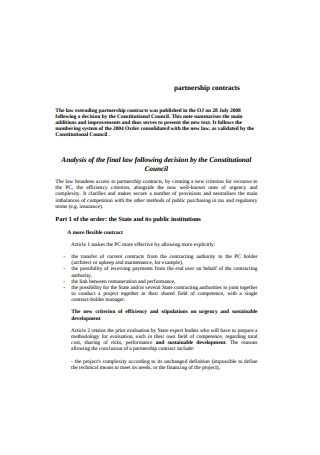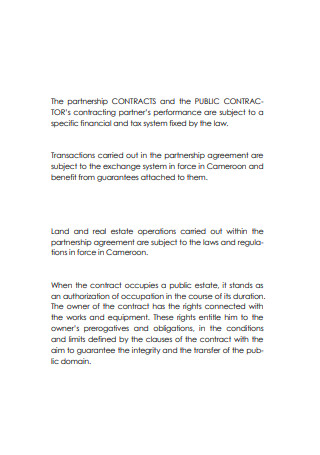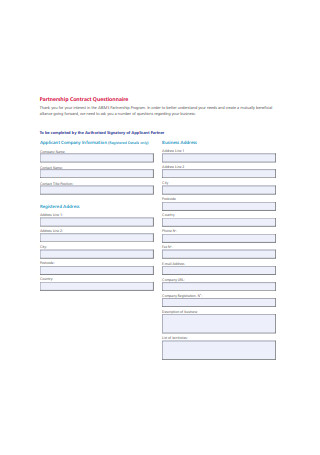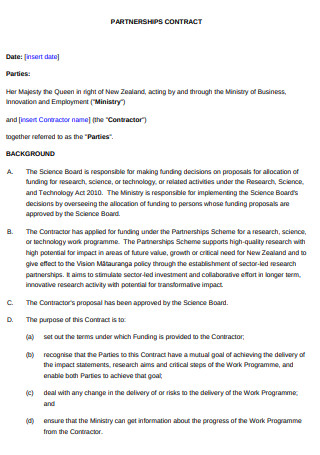26+ Sample Partnership Contracts
-

Public Institution Partnership Contract
download now -

Bus Safety Partnership Contract
download now -

Sample Partnership Contract
download now -

Product Partnership Contract
download now -

Enforcing Public Private Partnership Contract
download now -

Public Partnership Contract
download now -

Partnership and Sequential Contract
download now -

Farmer Partnership Contract Sample
download now -

Business Partnership Contract Sample
download now -

Individual Partnership Contract Sample
download now -

Simple Partnership Contract
download now -

Partnership Contract Example
download now -

Public Private Partnership Contract Sample
download now -

Partnership Contract Questionnaire Sample
download now -

Small Business Partnership Contract
download now -

Formal Partnership Contract
download now -

Commercial Partnership Contract
download now -

Report on Public Private Partnership Contract
download now -

Investment Club Partnership Contract
download now -

School Partnership Contract Sample
download now -

Manufacturer Partnership Contract
download now -

Partnership Investment Contract
download now -

Delivery Partnership Contract
download now -

Business Non Partnership Contract
download now -

Sample Partnership Agreement
download now -

Standard Partnership Contract
download now -

Checklist for Developing a Partnership Contract
download now

“Between 1980 and 2011, the number of partnership businesses grew from 1.3 million returns to 3.2 million returns.” (Source: Tax Foundation)
“Statistics show that up to 70 percent of partnerships fail completely.” (Source: Entrepreneur)
What Is a Partnership Contract?
A partnership contract is a legal document that establishes the terms of the relationship between two or more business partners. The partners may be classified as active participant’s business operations in the business operations or they may remain as passive contributors to the business venture’s initial capital. The partnership agreement generally states the nature of the business venture, the money invested by each party, and the rights and responsibilities to uphold.
Though it doesn’t always have to be in a written format, it’s best to document the agreement in the event of a dispute. A written contract is considered enforceable in court if it contains all the necessary elements of a legally binding agreement. The partnership contract will also govern how much of the profit each party is set to receive each year to ensure clarity and coordination.
Types of Partnership Contracts
Partnerships involve a give-and-take scenario between parties. Here, partners may be liable for debts of the business and for lawsuits that are filed against them, which is usually determined based on their type and amount of participation in the activity. Business contracts that are created for this type of arrangement vary depending on the relationship that the concerned parties share. To find out more, let’s discuss their differences below.
How to Write an Enforceable Partnership Contract
If you plan to open a business with a partner, a written contract is a vital part of your plans. This allows you to convey your principles and responsibilities in a clear, coherent manner for all parties to grasp. A good partnership contract will help settle conflicts when they arise to prevent minor misunderstandings from erupting into full-blown disputes as well.
So, what should a legally valid partnership contract include? Here’s a step-by-step guide to browse you through the process.

Step 1: Identify all parties.
Begin writing the contract by naming all the parties in the agreement. Even if you have someone to sign the deal on behalf of your company, it’s still important to indicate the name of the entity that he or she represents. Also, make sure to agree on a name for your partnership. Some individuals like to use their last names for recognition, but you can adopt and register a fictitious business name for a unique approach. Partnership contracts must contain the full legal title of the business, which includes designations such as “Incorporated” or “LLC.” Other identifying information may also be added if necessary.
Step 2: Describe the role of each partner in the agreement.
There are significant areas that the legal document must cover, such as each party’s contribution to the partnership, the allocation of profits, losses, and draws, partners’ authority and decision making, as well as the management duties of each partner. It’s important to work out who’s responsible for contributing cash, property, or services to the business before it opens to the public. Each partner will have an ownership percentage based on what they bring to the table. Note that you and your partner also have different views when it comes to how finances should be divided and distributed among parties, so you must pay close attention to what your partner has to propose. The same mindset applies to the rest of the decisions that influence the final outcome of your partnership agreement.
Step 3: Define the scope of work.
The body of the contract is comprised of the terms and conditions to be agreed upon among partners. This includes the scope of the word or service to be rendered, along with a proposed timeline for its completion. Keep in mind that some partnerships are project-based only, so they’ll likely come to a close once the joint project has been completed. The responsibilities in the agreement must be as specific as possible to make sure that each party is fully aware of what is expected of them. You also want to consider scenarios that could affect the flow of activities. To protect your company’s liability, carefully word your contract to make sure that changes, substitutions, and occurrences that are beyond your control are taken into account.
Step 4: Determine the length of the contract.
Most business contracts are signed and in effect for a specific length of time, such as a year or so. By the end of this contract period, parties can decide whether to renew the contract under the same terms or to revise it under new provisions. The other party may also choose not to sign the contract for another term and terminate the partnership altogether. This all depends on the situation at hand, as some partners might not have been satisfied with the performance of the joint venture and would instead try out new opportunities elsewhere. Defining the duration of your contract will make it easy for either party to raise prices or modify parts of the agreement that they aren’t pleased with.
After all, ending the business relationship before a new one starts is a lot better than committing a breach to an ongoing contract.
Step 5: Specify how disputes will be handled.
Disagreements are inevitable in any business venture. They are bound to occur despite your rigorous efforts to prevent them, so it’s best to form an agreement that will help you resolve them without help from the outside. When it feels almost impossible to agree on the same thing, a lawsuit is the last thing you want to deal with. In your attempt to settle matters amicably, you can include stipulations that indicate the use of a mediator rather than the court of law. Apart from saving you thousands of dollars in legal fees, this will also spare you from the long hours spent during court hearings and meetings with your lawyers. If you have other ideas that could help settle the dispute, feel free to put them in writing.
Step 6: Sign and date the contract.
There’s a good reason why a contract comes with a signature block, and that’s for you to sign it. This area must contain the name of the entity, a signature, followed by the name and title of the person who signed it. Each signee should indicate the date when the contract was signed, which is usually written right next to the signature for it to remain visible. However, the individual who signs the contract must also have the authority to make the final decision. For partnerships, only general partners are authorized to sign the contract in place of the limited partner. Always be sure to verify this information before executing the agreement.
The Dos and Don’ts of Partnership Contracts
Successful contracts ensure you get the return on investment that you negotiated through the proper approach. From the initial establishment of a partnership to its continuing growth and advancement, a contract is vital to help arrange the terms of an agreement and meet the best interests of those involved. With all this in mind, following the right writing practices is bound to minimize misunderstandings and disputes in the future. Below are a few simple tips to apply when drafting your partnership agreement.
What to Do
1. To begin with a standardized structure.
You want to follow a consistent structure with all of your contracts. This can be used for reference as you customize each legal agreement to the circumstance you are in. If starting from scratch sounds intimidating, you can opt to download a free contract template to get an outline for your partnership contract. Simply personalize the document to meet your exact requirements, and you should be settled.
2. Do use plain language.
Remember to use simple language that isn’t specific to a particular industry or field of expertise. This will make the contract easier to read and comprehend by the average person. It’s a good idea to avoid using too much legalese as well. Otherwise, there’s always a chance that other parties will end up agreeing to something that they don’t fully understand. If you can get your point across in plain English, being straightforward with your terms and conditions will eventually lead to smooth negotiations and processing.
3. Do label sections as necessary.
Make it easier to identify specific provisions by using logical headings and numbers for each section and clause. This will come in handy during discussions and arguments with the other party. Instead of repeating the entire provision word for word, you can refer to its heading and number as an alternative. Labellings must be done appropriately to prevent confusion.
4. Do be careful in applying punctuations.
Commas, semicolons, and periods have the power to change the entire meaning of a sentence when misplaced. The same goes for conjunctions that aren’t used in the right context. Be wary of these mistakes, as parties tend to rely on what’s already on print as opposed to the matters that you try to clarify verbally. Thus, you must proofread the contract multiple times until it is finally free of errors.
5. To discuss any questions or concerns with a contract lawyer.
Although hiring an attorney to guide you in drafting the contract is not a necessity, it would still be helpful to have an expert educate you on matters that you aren’t familiar with. Be honest with yourself and ask anything that’s on your mind. An attorney that specializes in contract law will be happy to offer you insights on topics that are new to you. This will also help you clarify clauses that you’ve been doubtful about. It is better to have everything confirmed early on before you regret signing a contract that you don’t fully agree to.
What to Avoid
1. Don’t use form contracts.
A fill-in-the-blanks contract might seem like a convenient method of drafting the document, but they aren’t advisable in most cases. You want to use a material that will quickly adapt to your circumstances and business goals. A contract template does provide this option, as long as you choose the right one. If so, be sure to run through the document to determine whether it passes the standard legal requirements and your business needs.
2. Don’t use excessively long sentences.
Lengthy sentences are not only a bore to read, but they also cause ambiguity and other complexities. You don’t want to make it difficult for people to grasp what you mean to say, as this will only lead to various disputes later on. Instead, break them down into simple, digestible sentences that still manage to convey your message correctly. Splitting large chunks of texts into a simplified version of such is sure to make your contract easier for internal and external parties to comprehend.
3. Don’t assume that all terms would be defined the same way.
It’s common for organizations to enter into a partnership with an individual or company from a different line of business. Hence, you can’t assume that your business partner will interpret your contract in the same way. That is why technical terminologies must be defined in the initial sections of the document. This will eliminate any doubts or confusions that readers might have regarding critical provisions found in the contract. Further clarifications can also be discussed in person, as long as they don’t directly impact the agreement.
4. Don’t agree to an amendment without putting it to paper.
If you wish to modify or add new terms to the contract, make sure these changes come in a written format. Oral revisions can’t always be trusted, especially when they can easily be forgotten or altered differently than what was initially agreed upon. These changes can only be applied if all parties have read, understood, and accepted the adjustments. If not, negotiations should carry on until you can finally reach a mutual agreement.
5. Don’t include any irrelevant points.
Avoid incorporating pointless materials that don’t play a part in the acts indicated in the partnership contract. This will only make the document unreasonably long for people to read. As implied multiple times before, focus on creating an arrangement that is relevant and essential to your specific purpose. It’s essential to write a contract that parties can effortlessly read as you finalize the business partnership agreement.
There are several things to consider before you enter into a joint business venture with your partner. Since the last thing you want to do is to wait around for conflict to arise, it’s best to spell out your terms in complete detail to keep everyone on the same page. A well-written contract can foster the relationship you have with your partner in ways that promote clarity and participation. That way, the protection of each party’s interests is kept a priority. Get started with your partnership contract today by using the appropriate contract or agreement template that suits your case.
